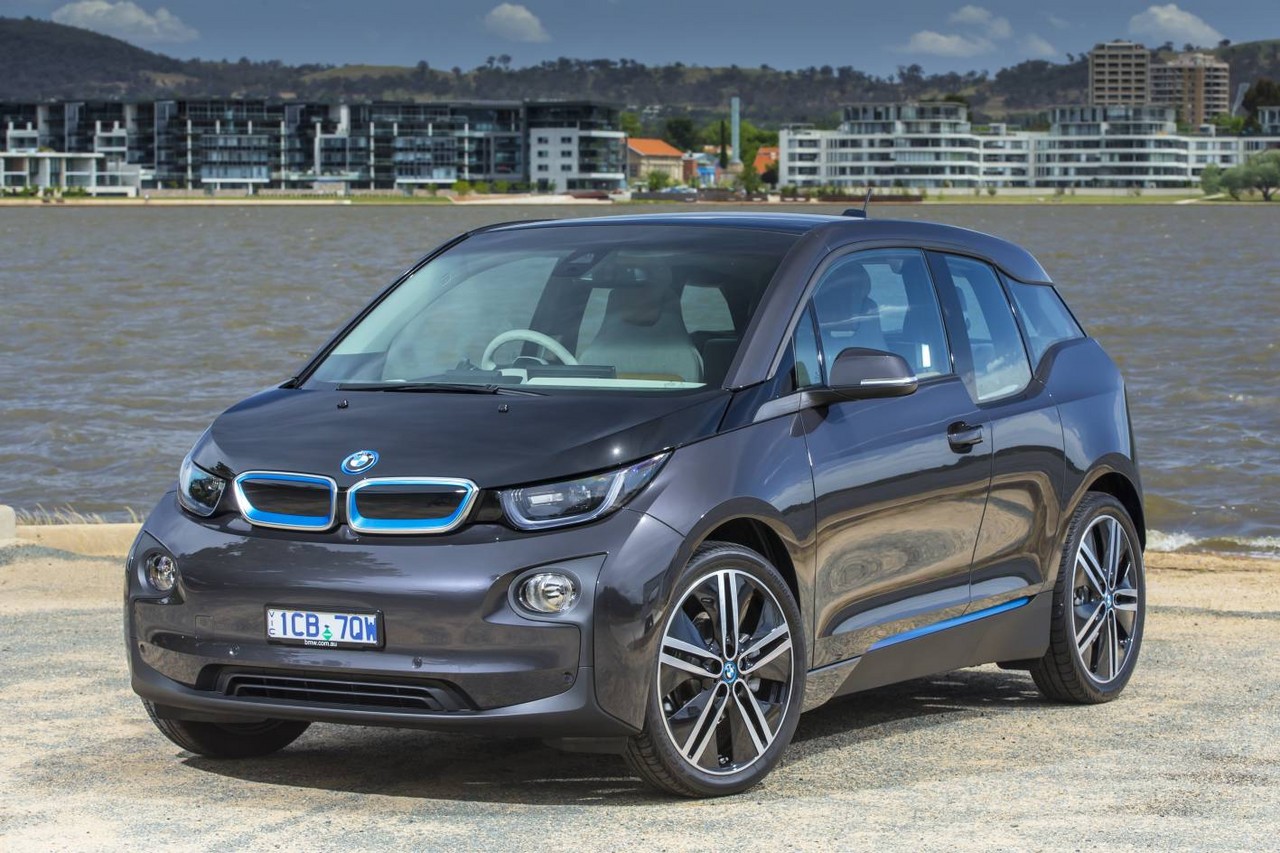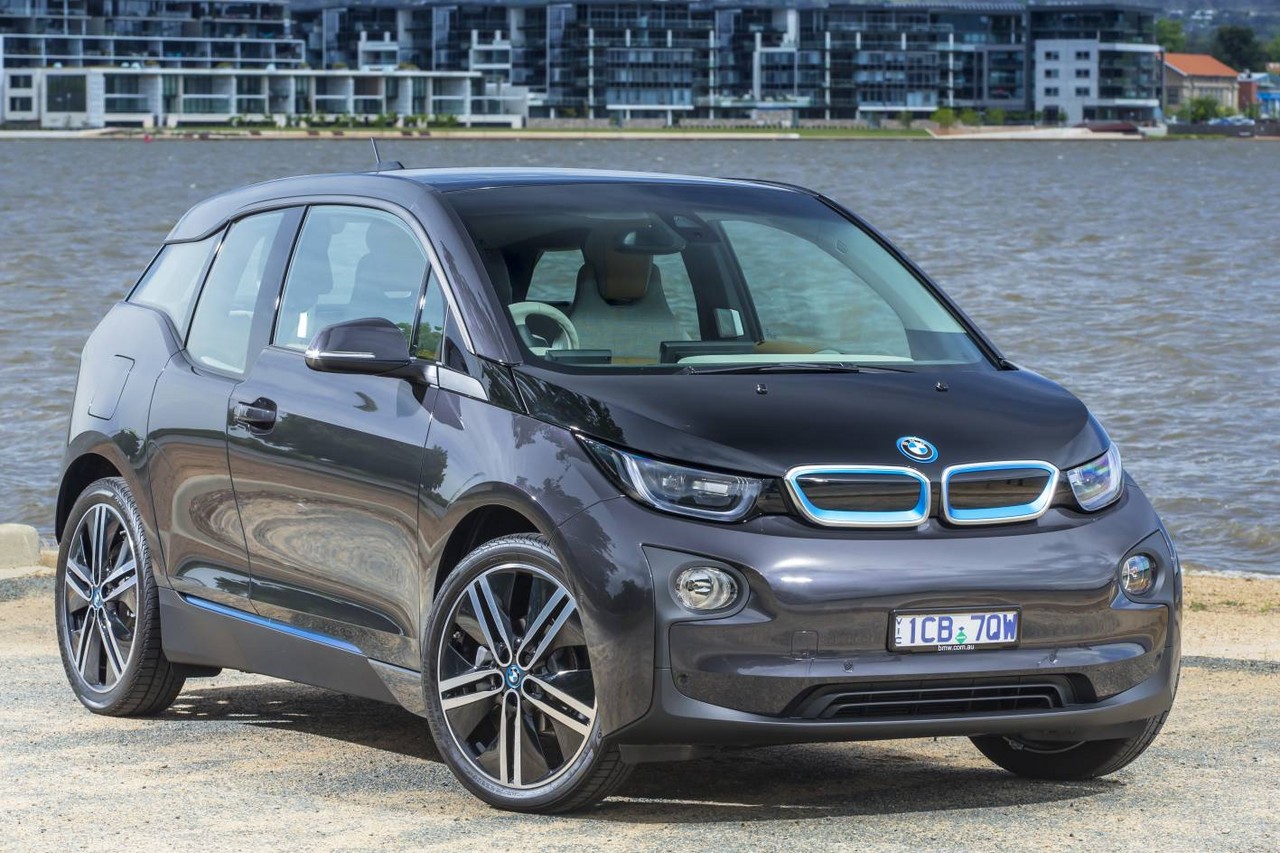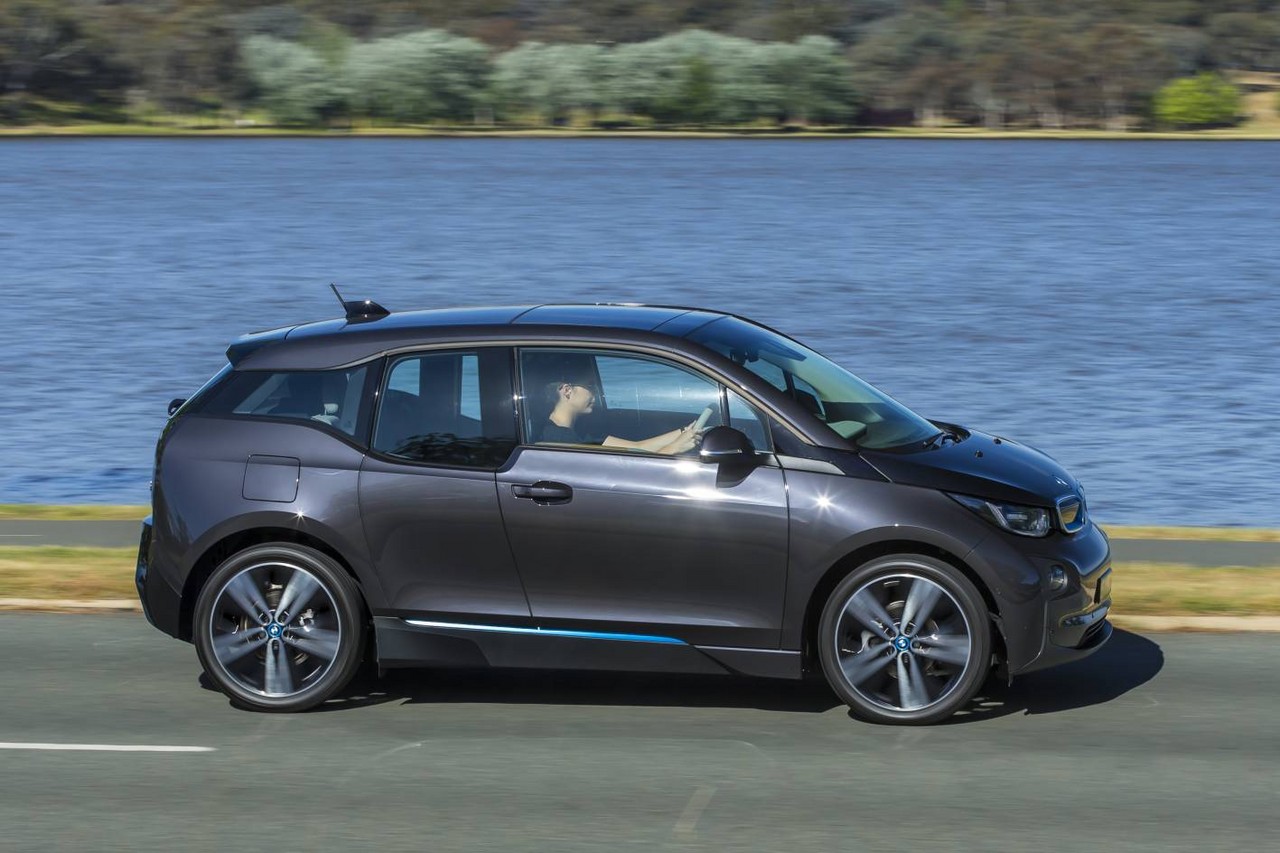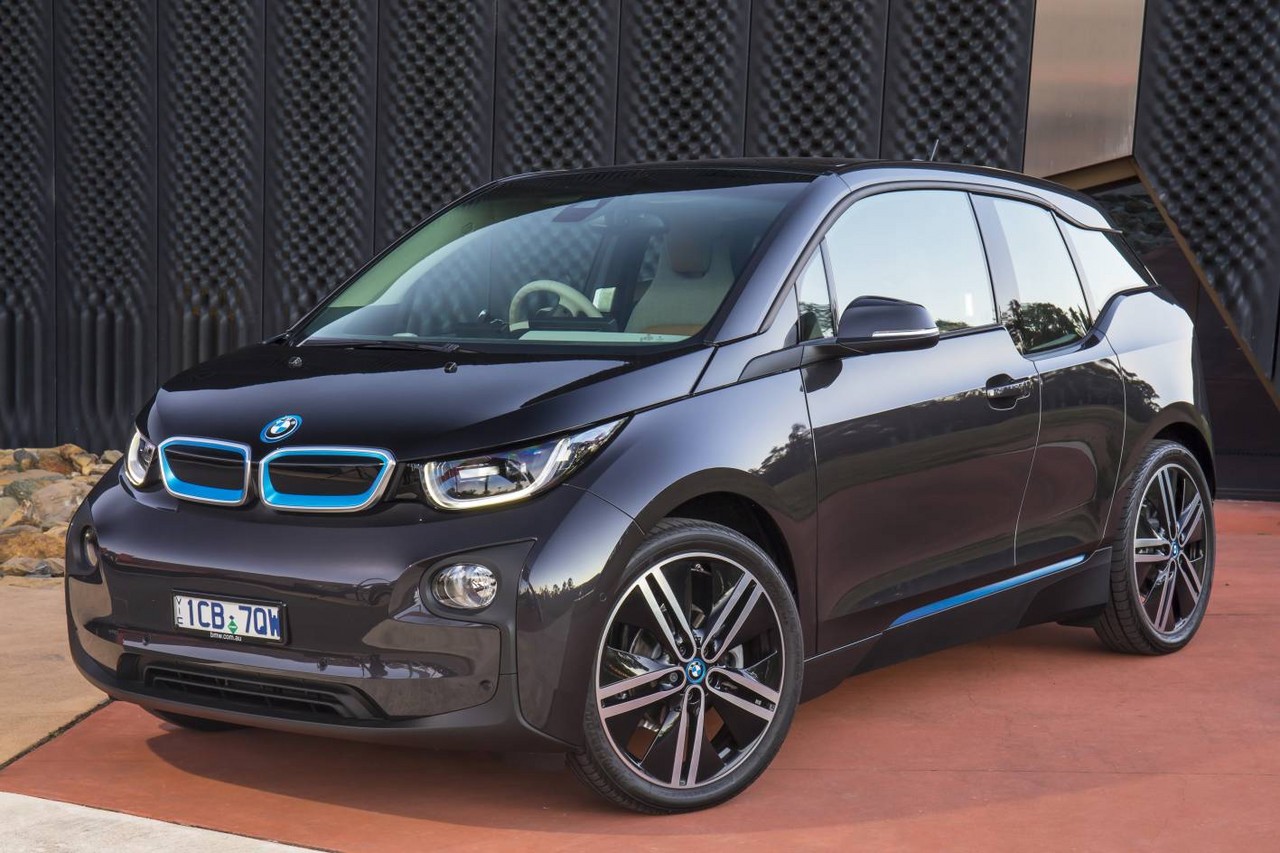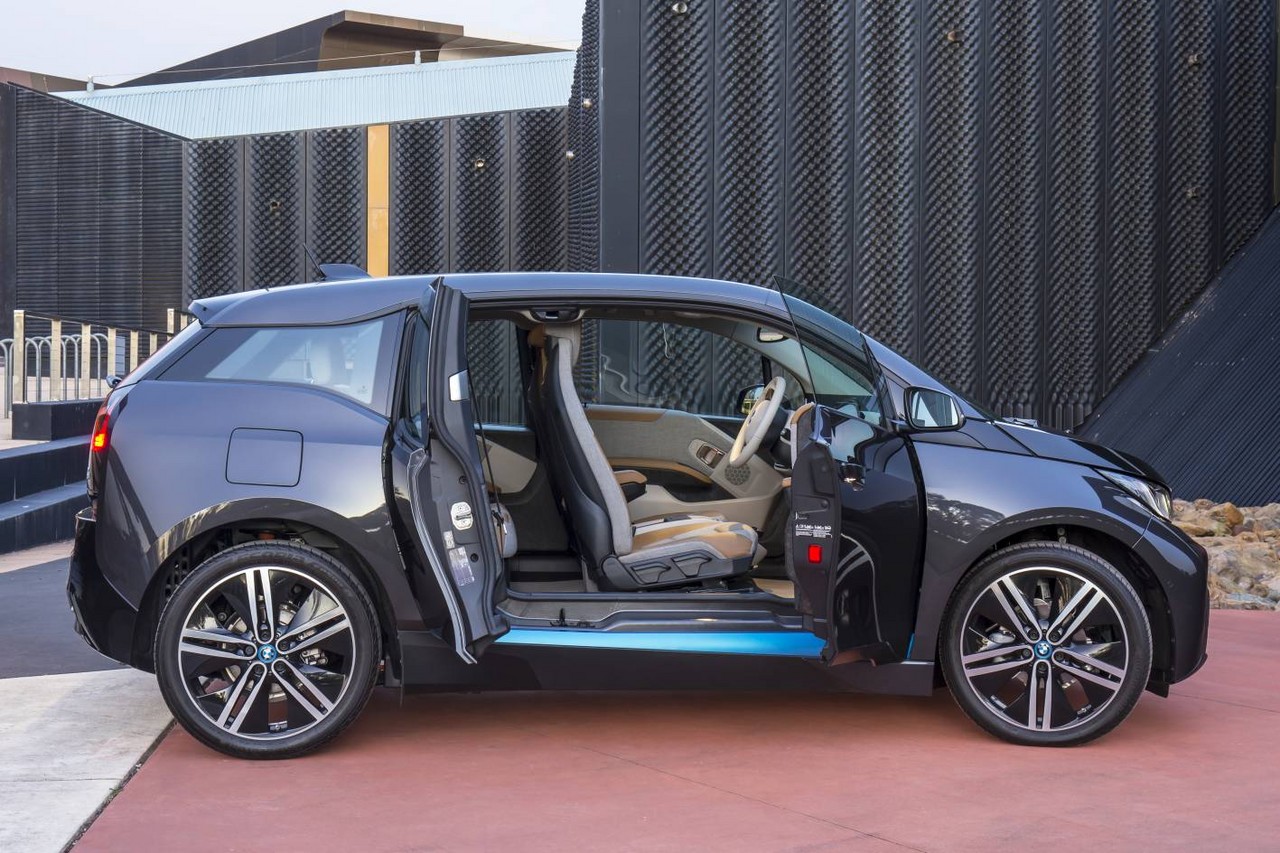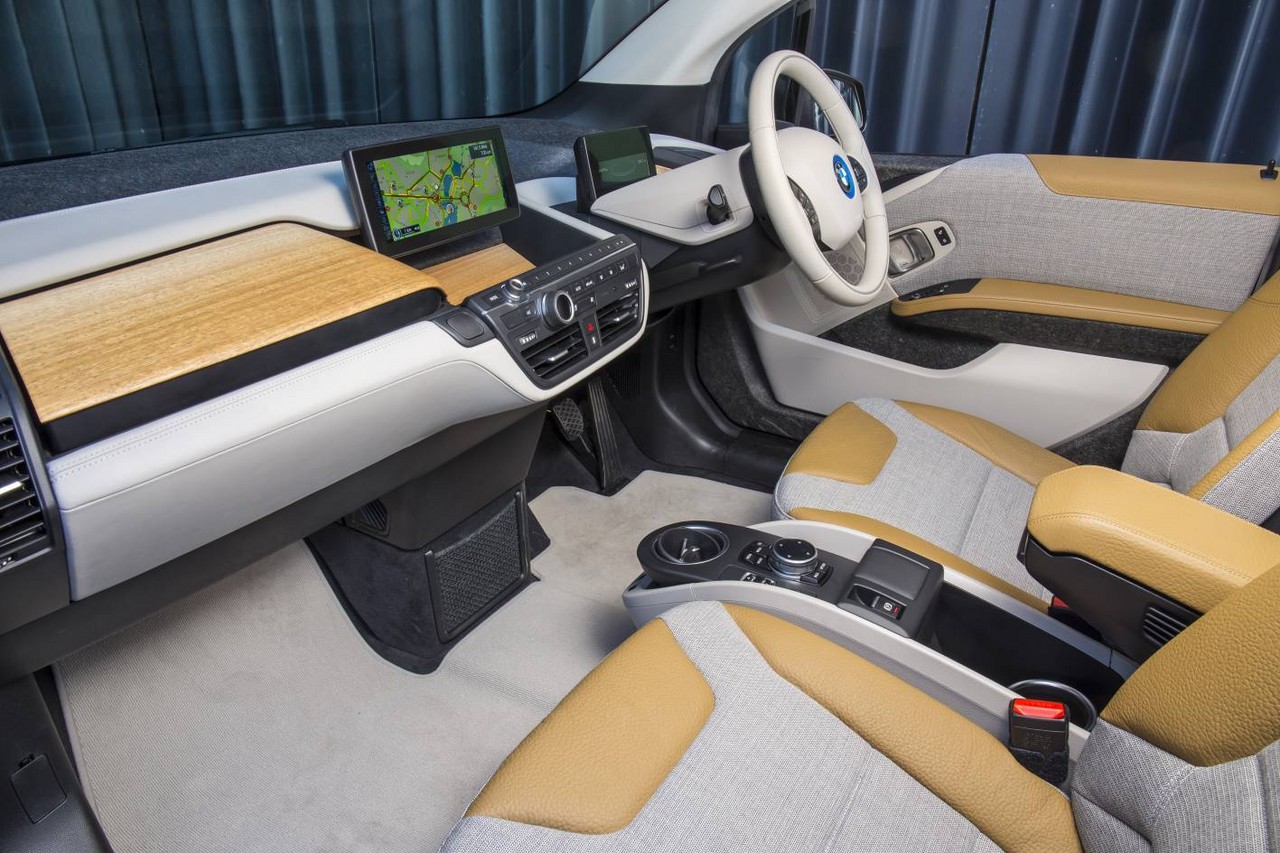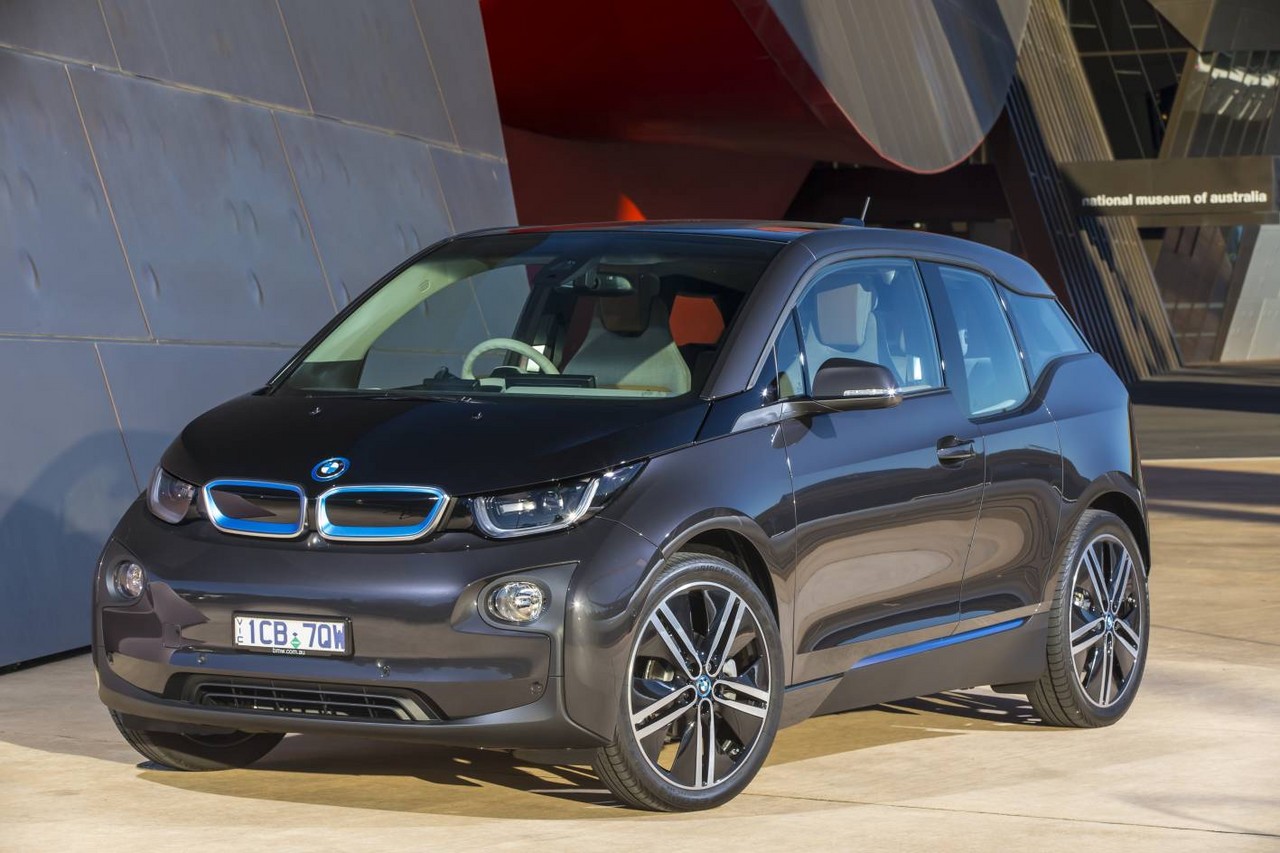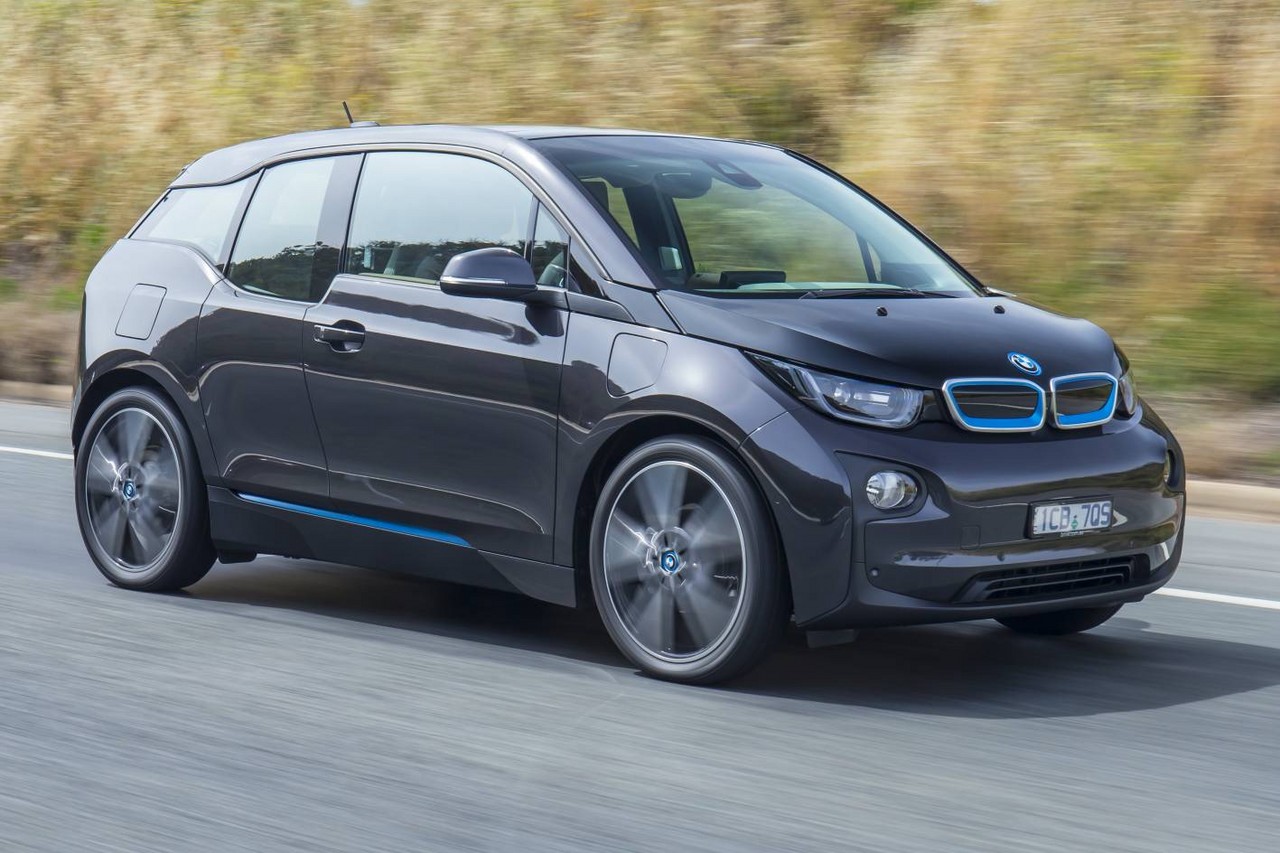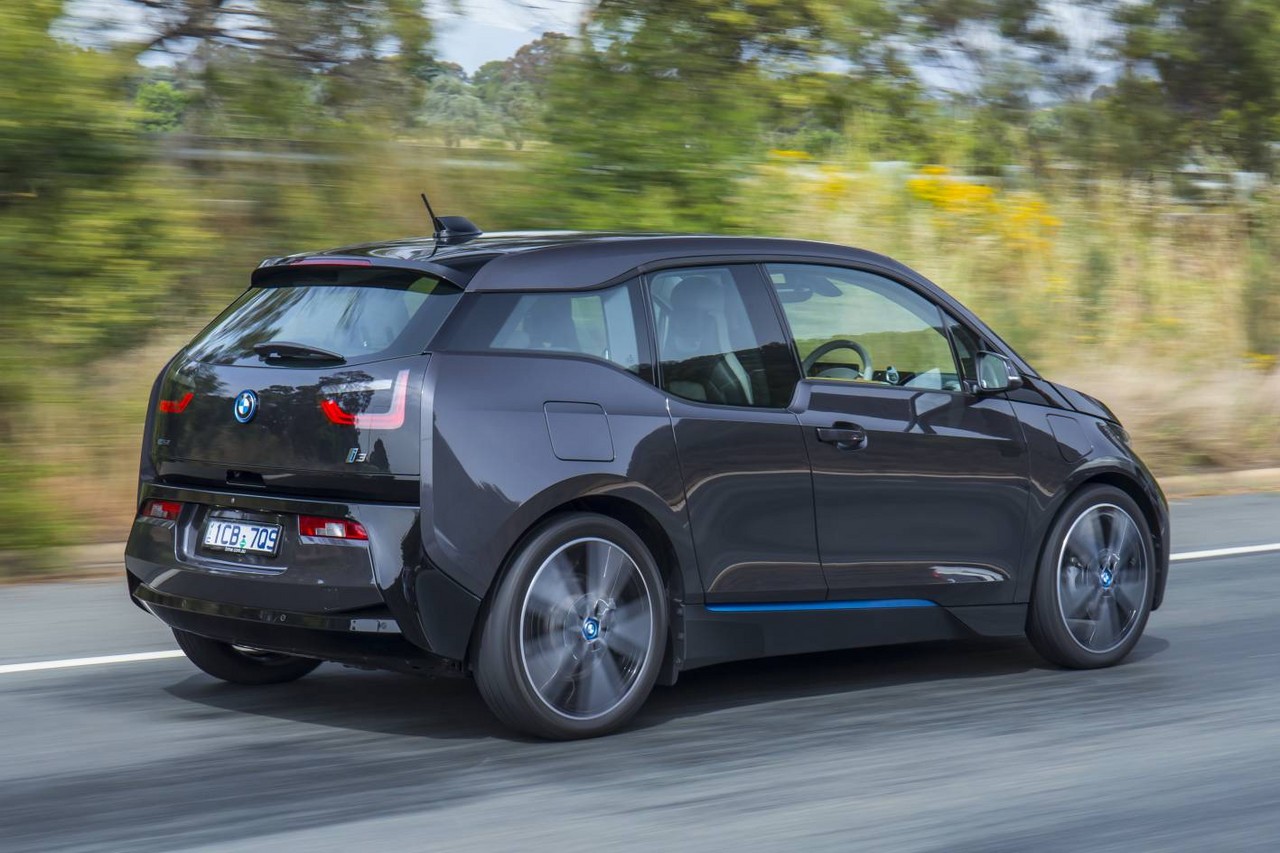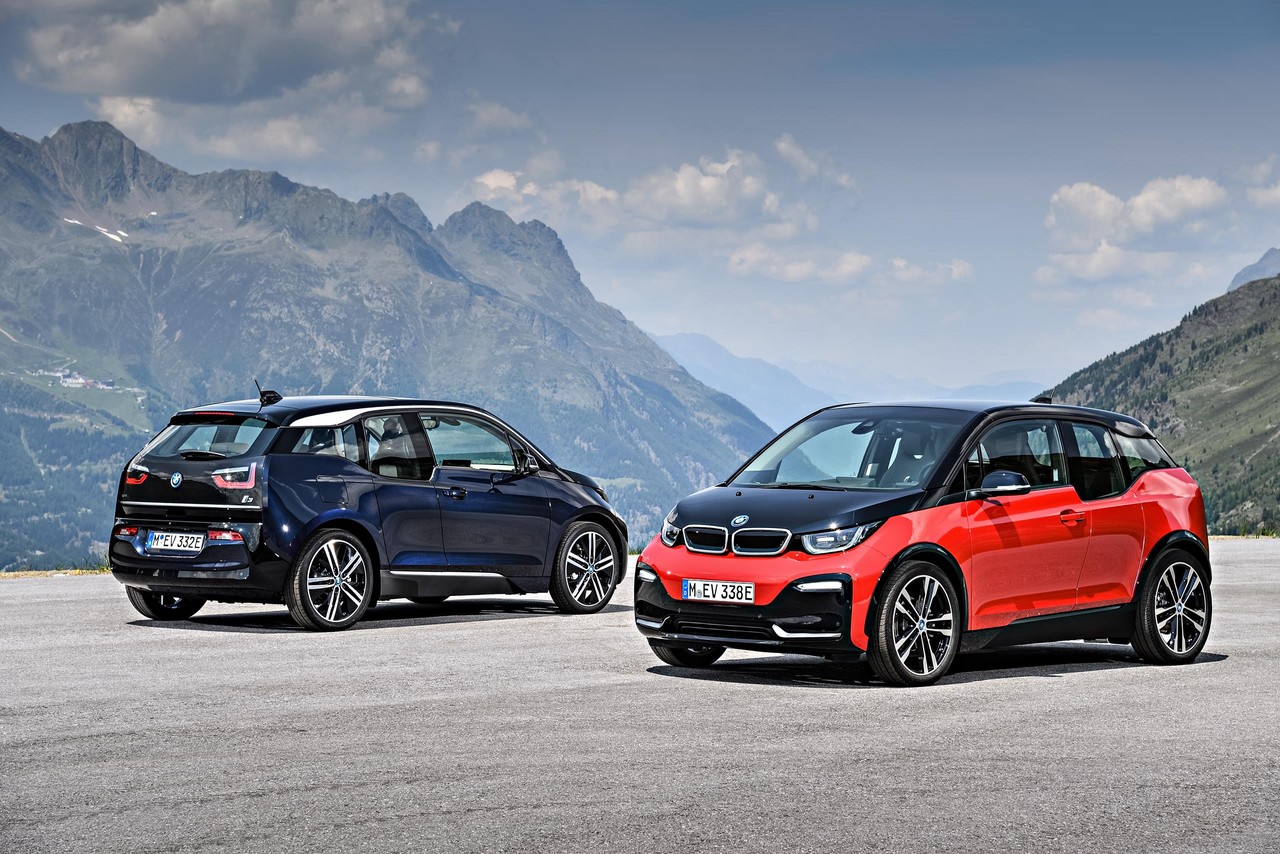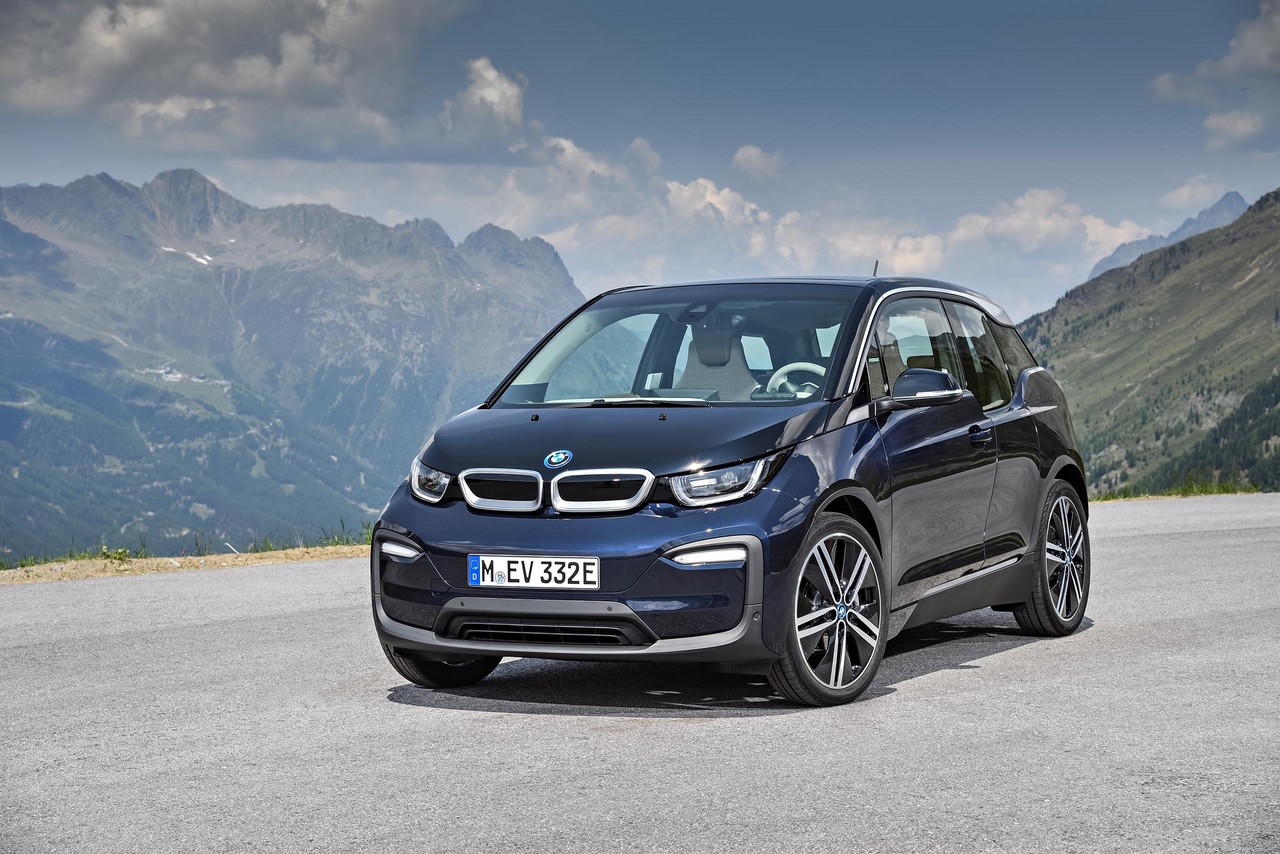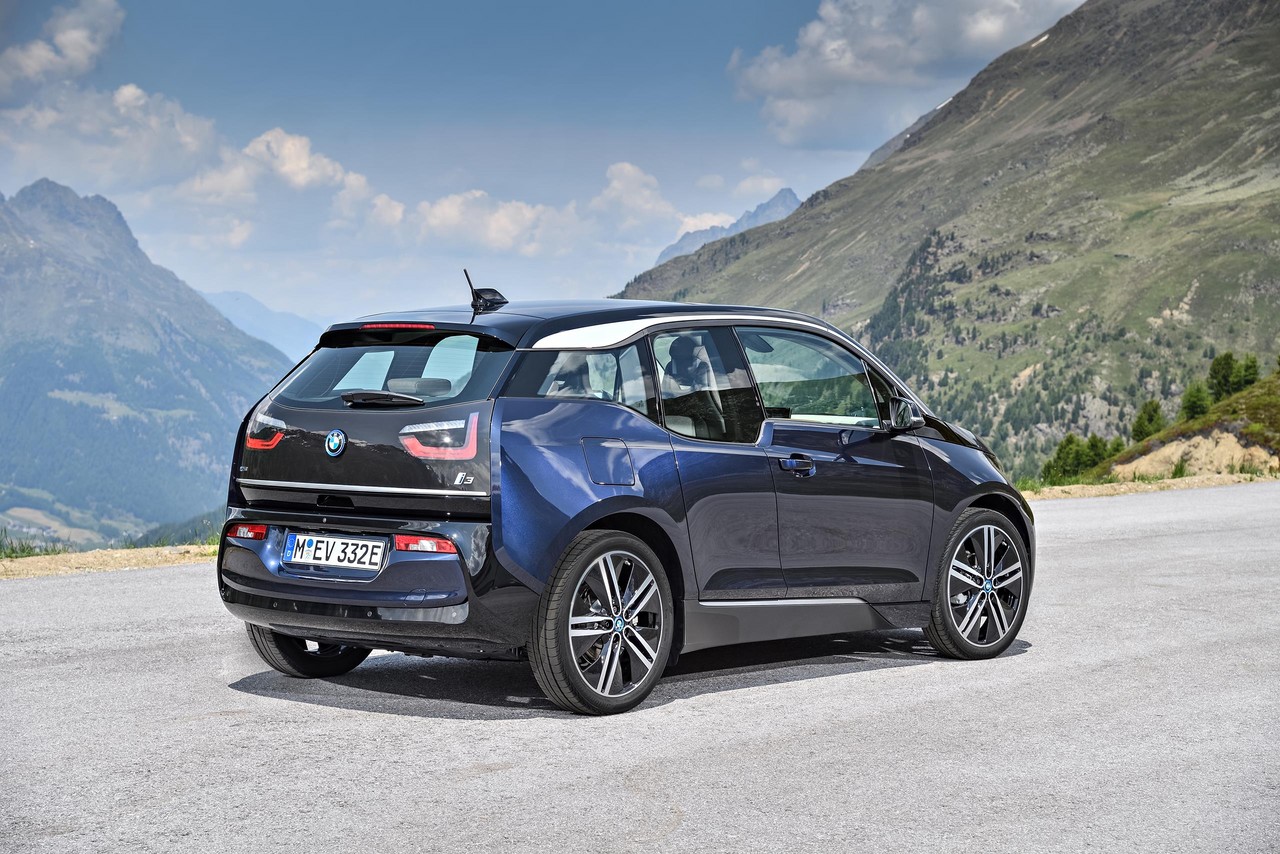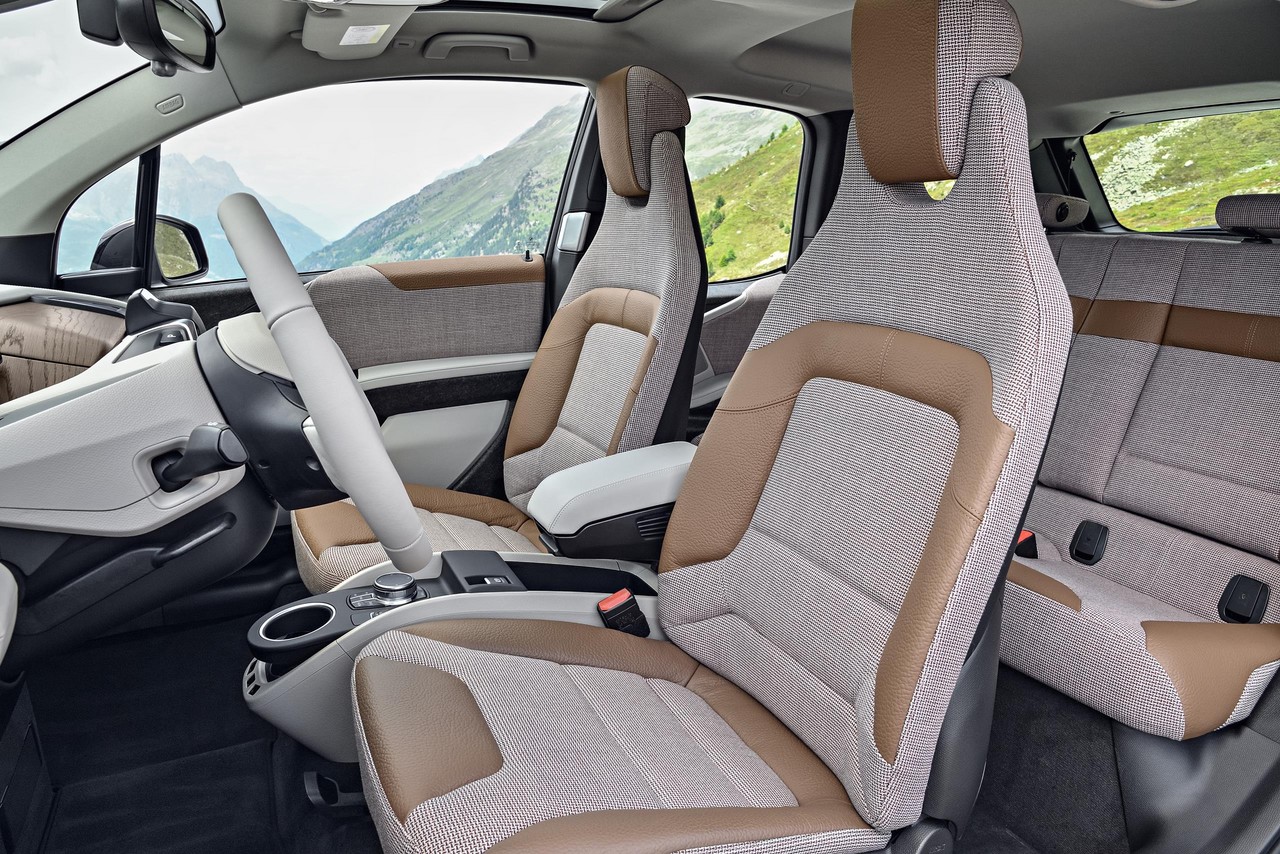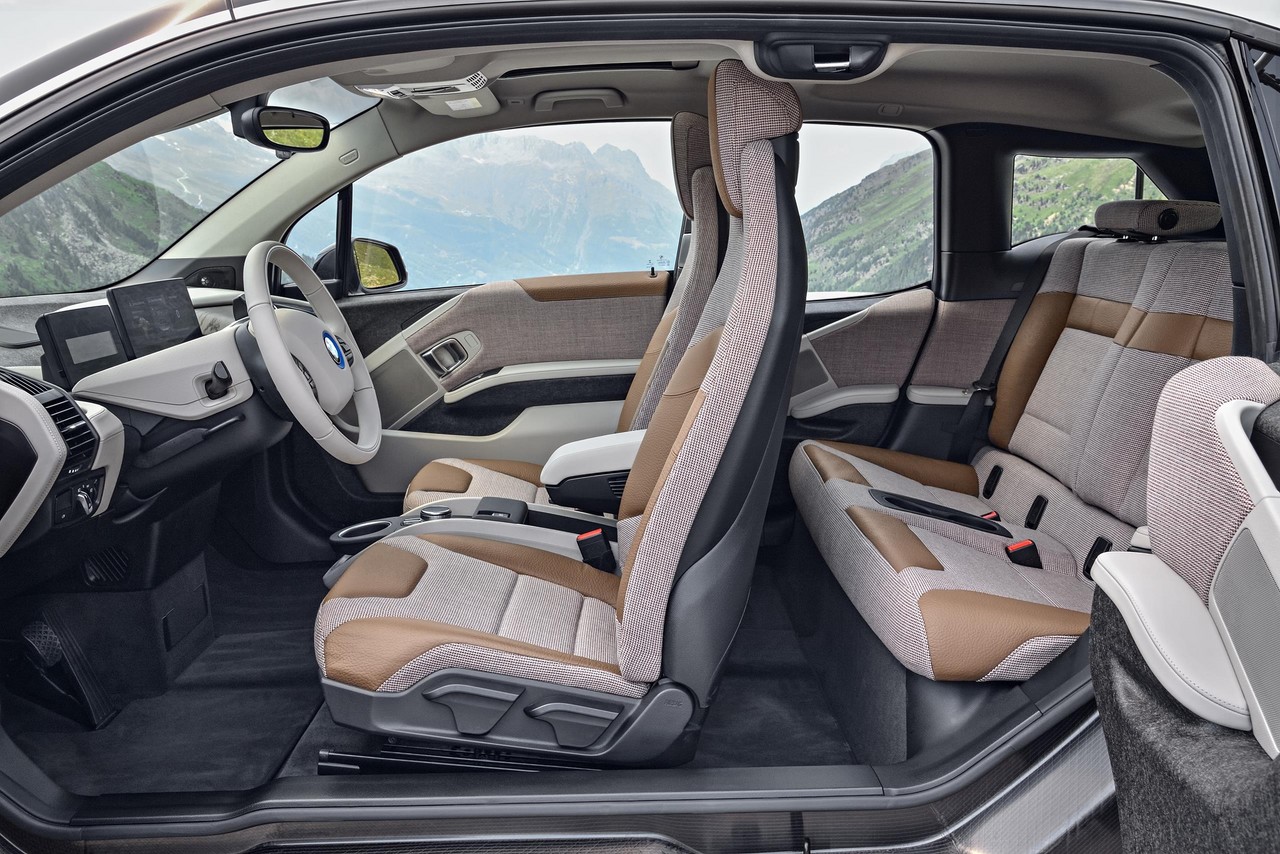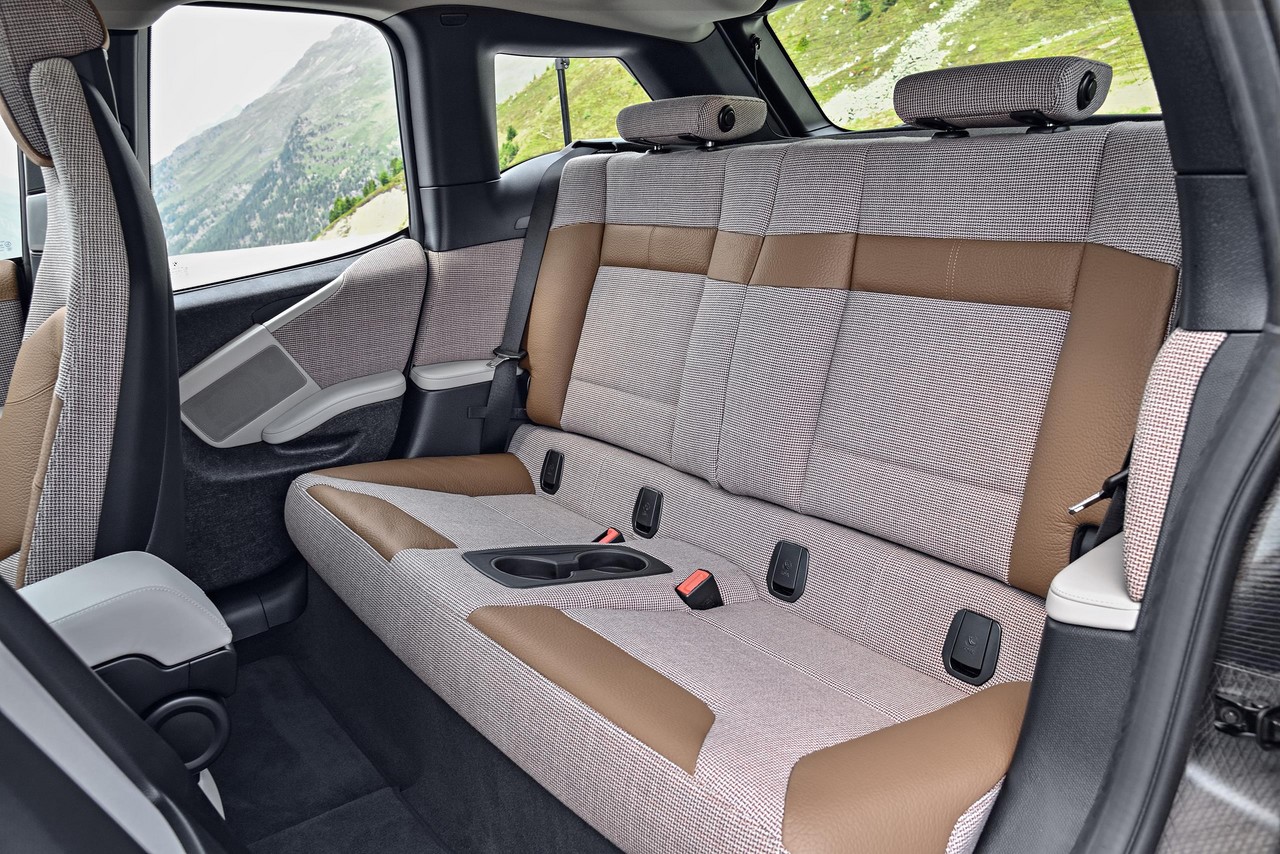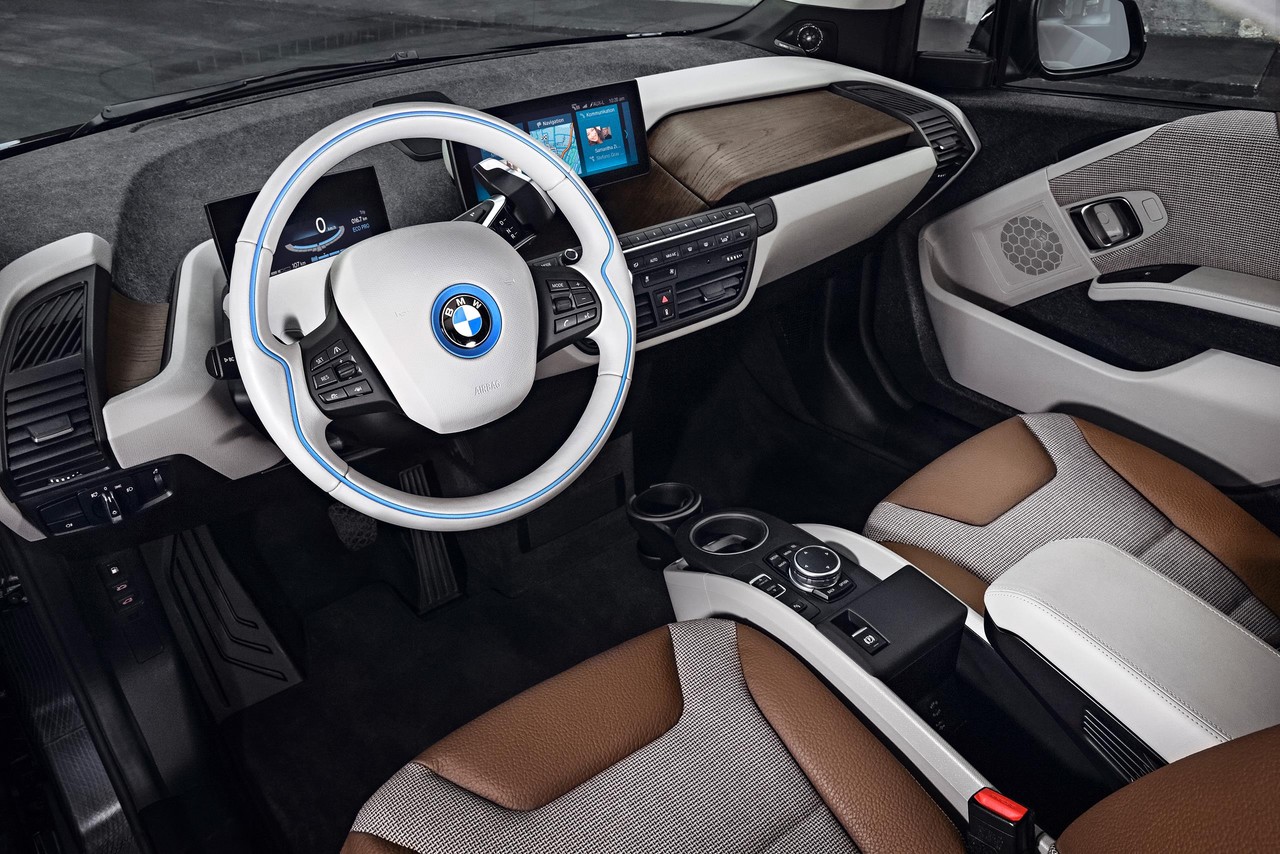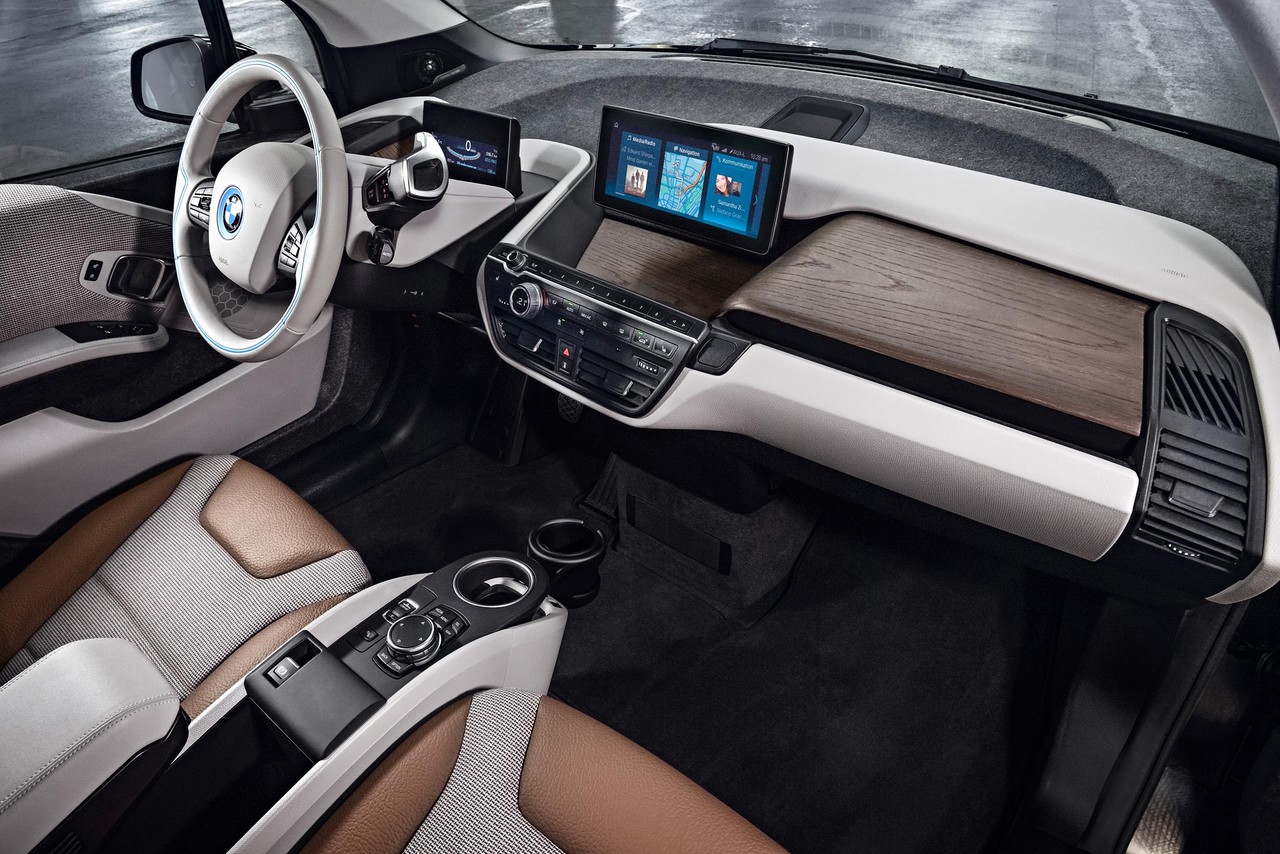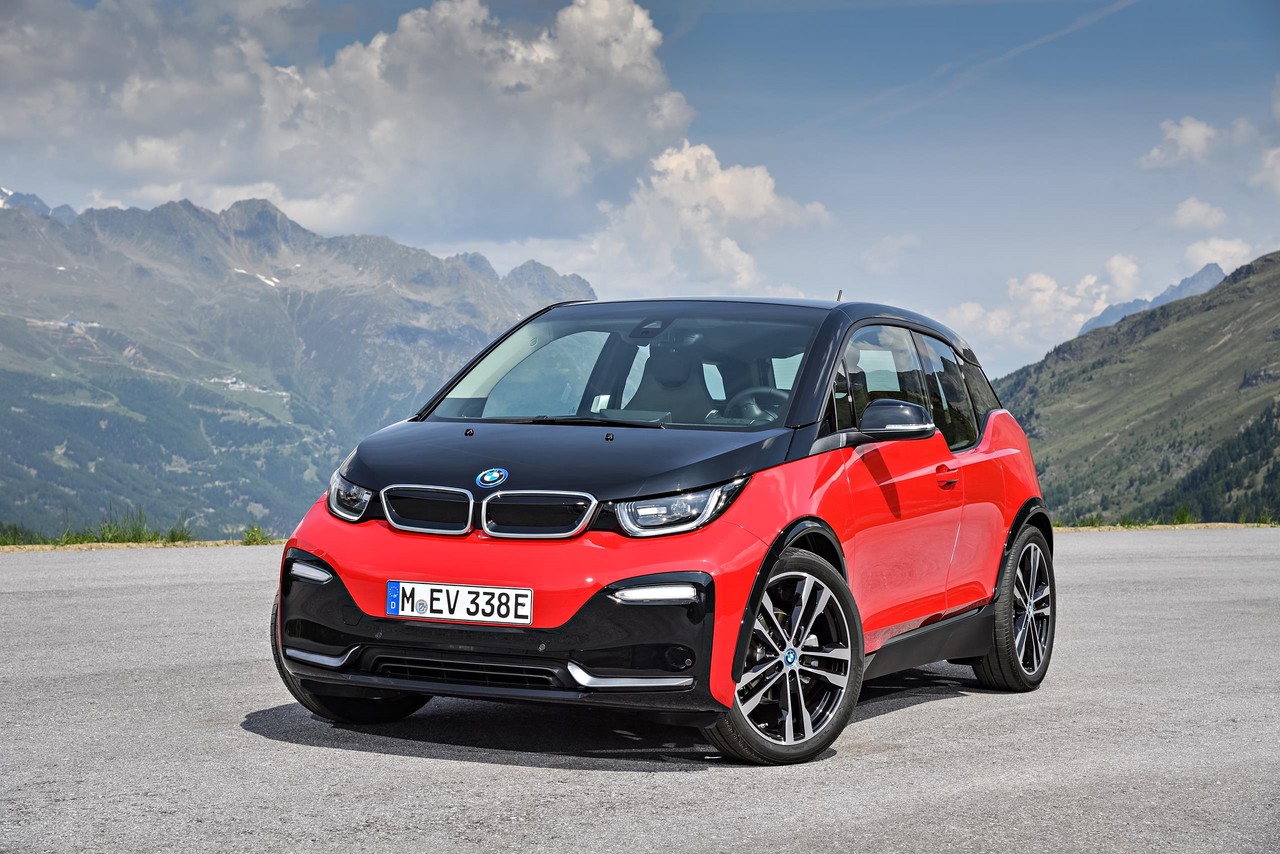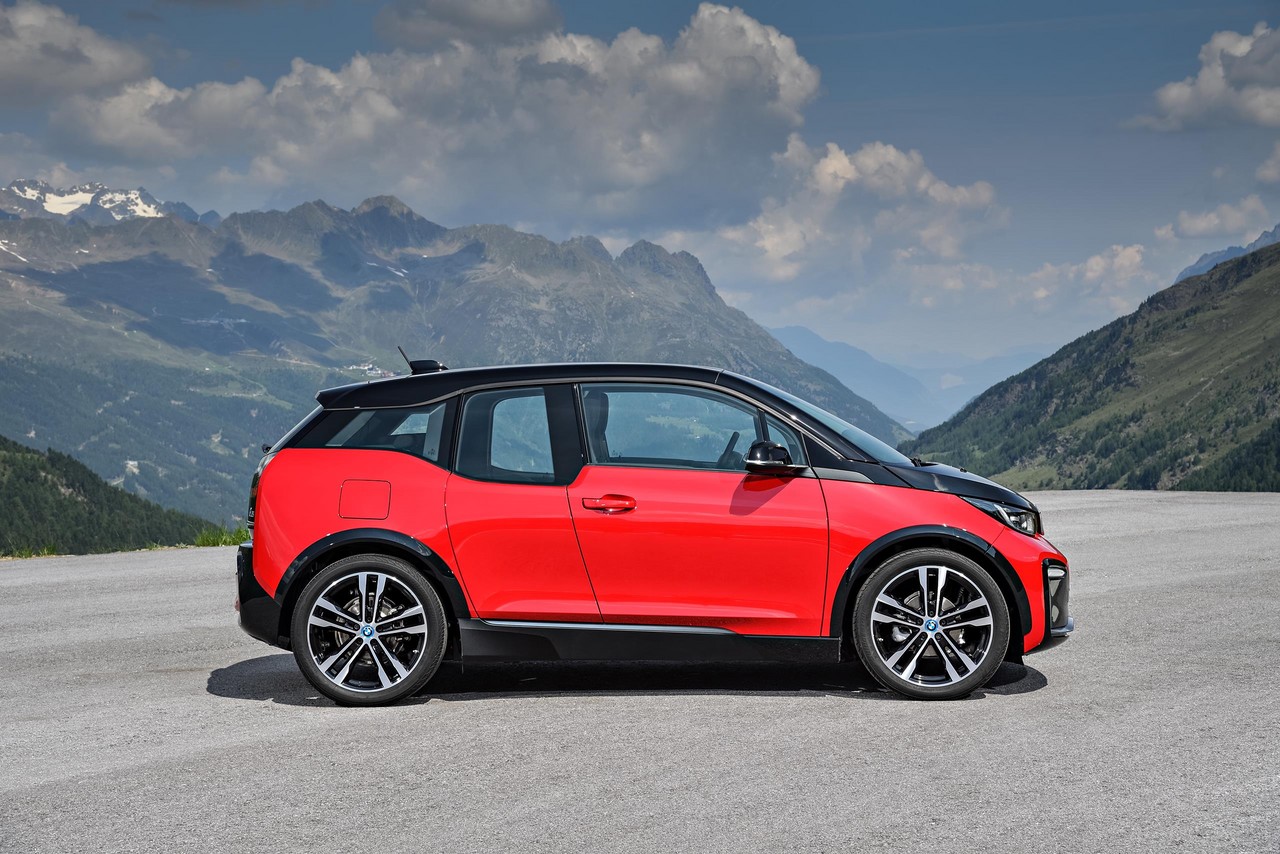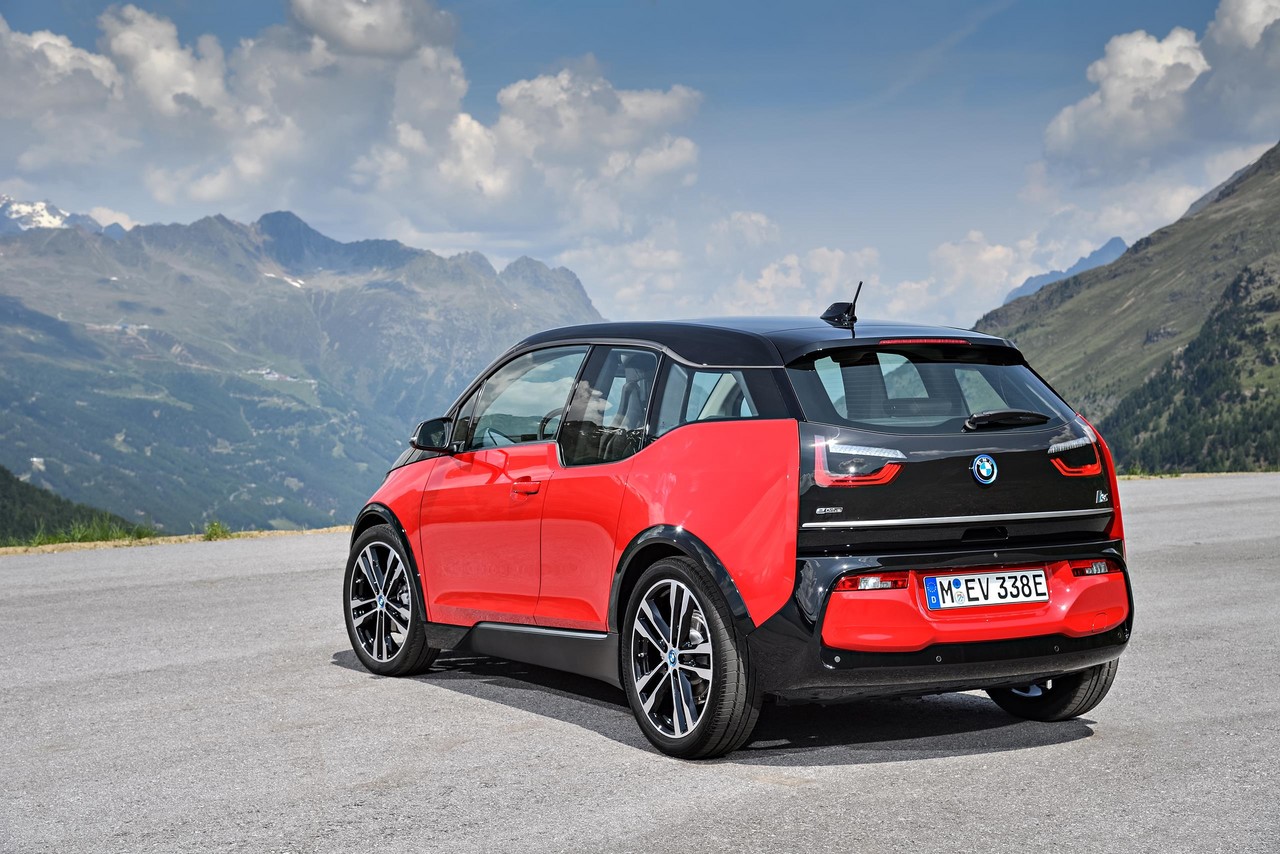
- Responsive electric motor
- Quiet driving experience
- Tight turning circle
- Generally competent ride/handling balance…
- … but short-travel suspension struggles with bumps
- Overly sensitive steering
- Small boot
- High retail price
- Four star Euro NCAP safety rating
Review: BMW I01 i3 (2014-17)
Overview
Released in Australia in November 2014, the BMW I01 i3 was a four-seat, five door hatchback that was available with electric and hybrid powertrains. Manufactured in Leipzig, Germany, the rear-wheel drive BMW i3 initially had a 60 Ampere-hours (Ah), 22 kWh lithium-ion battery that was positioned under the vehicle floor. According to BMW, the battery was designed to last the life of the vehicle and had an eight year or 100,000 kilometre warranty. From October 2016, however, a higher capacity 94 Ah, 33 kWh battery replaced the 60 Ah battery.
While the BMW i3 was fitted with both accelerator and brake pedals, the driver could engage a single-pedal control system so that a speed-sensitive ‘braking recuperation mode’ would apply a controlled braking effect when the driver lifted their foot off the accelerator pedal.
BMW i3: Range
In its electric form, the BMW i3 60 Ah was estimated to have a driving range of 130 to 160 kilometres when driven in ‘Comfort’ mode. However, the Eco Pro mode could extend this range by approximately 20 kilometres (i.e. 150 to 180 kilometres), while Eco Pro+ extended range by a further 20 kilometres (170 to 200 kilometres) by adjusting accelerator mapping and limiting the top speed to 90 km/h. Furthermore, the i3 could accelerate from rest to 60 km/h in 3.7 seconds and from rest to 100 km/h in 7.2 seconds; top speed was limited to 150 km/h.
For the BMW i3 94 Ah and BMW i3 REx 94 Ah, BMW stated that these vehicles had ‘every day’ driving ranges of 200 km and 320 kilometres, respectively.
REx (Range Extender)
In addition to the electric engine, the BMW i3 REx (range extender) had a 650 cc two-cylinder petrol engine that was mounted adjacent to the electric motor above the rear axle, while its nine-litre fuel tank was located in the front of the vehicle. If the charge of the lithium-ion battery fell below a specified level, the range-extender engine would act as a generator to maintain charge, such that the petrol engine did not drive the wheels. With the range-extending engine, maximum range in ‘day-to-day driving’ was estimated at 300 km.
| Motor | Trans. | Peak power | Peak torque | |
|---|---|---|---|---|
| i3 | Synchronous electric motor | 1sp | 125 kW | 250 Nm |
| i3 REx | Synchronous electric motor | 1sp | 125 kW | 250 Nm |
| 647 cc W20K06U0 petrol I2 | 23 kW at 4300 rpm | 55 Nm at 4300 rpm |
Body and dimensions
The BMW i3 was underpinned by BMW’s ‘LifeDrive’ architecture which consisted of an aluminium Drive module (the chassis) and a carbon fibre-reinforced plastic (CFRP) Life module (the passenger cell). Similar in principle to a body-on-frame design, the four-seat i3 had opposing “coach doors” and no B-pillars.
The BMW i3 was 3999 mm long, 1775 mm wide, 1578 mm tall and had a 2570 mm long wheelbase; kerb weight was 1195 kg (DIN). Cargo capacity for the i3 was 260 litres, though this increased to 1100 litres when the rear seats are folded.
Suspension
The BMW i3 had single-joint MacPherson strut front suspension and a five-link rear axle that was mounted directly to the Drive module.
Safety equipment
Standard safety equipment for the BMW i3 included dual front airbags, front side airbags, full-length curtain airbags, ABS, electronic brake force distribution, brake assist, electronic stability control, traction control and seatbelts with pretensioners and load limiters (front and rear). When driving at speeds of up to 30 km/h, the BMW i3 could produce an aural pedestrian warning to alert pedestrians of its approach.
From July 2016 production, the BMW i3 was equipped with BMW’s ‘Driving Assistant Plus’ as standard and this included the following active safety technologies –
- Forward Collision Warning and Pedestrian Warning: active at speeds up to 60 km/h, Collision Warning would detect if the i3 was closing too quickly on the vehicle ahead and alert the driver of a collision risk. Furthermore, the Pedestrian Warning function could detect the risk of hitting pedestrians on the road and alert the driver with visual and audible warning signals. If the driver did not respond to these warnings, autonomous emergency braking (AEB) would be initiated to reduce vehicle speed;
- Active Cruise Control with Stop&Go function: at speeds from 30 km/h to 210 km/h, Active Cruise Control can maintain a speed-dependent distance from the vehicle ahead. With the Stop&Go function, the vehicle can apply the brakes to bring the vehicle to rest and, once the traffic ahead begins to move, automatically accelerate if the vehicle had been stationary for a period between 1 and 3 seconds. If the vehicle has been stationary for longer than 3 seconds, the driver only needs to briefly press the accelerator or a button to initiate acceleration up to the previously set cruising speed; and,
- Speed Limit Info: could recognise speed limit signs and incorporate speed restrictions into the driver-selectable Speed Limiter function or Active Cruise Control (where fitted).
Euro NCAP testing
In Euro NCAP testing , the BMW i3 received a four star safety rating which included an 86 per cent adult occupant protection rating and an 81 per cent child occupant protection rating. In the offset crash test, protection of the driver’s chest was rated as adequate and lower leg protection as marginal. Maximum points were awarded in the side impact test; in the more severe pole test, however, chest protection was rated as weak.
Features: BMW i3
As standard, the BMW i3 was equipped with BMW’s ‘Professional’ navigation system which included a 10.25-inch colour display, 3D maps, live traffic updates, iDrive controller and an integrated 20GB hard drive for media storage.
Beyond this, standard features for the BMW i3 included 19-inch forged light-alloy wheels with 155/70 R19 front and 175/60 R19 rear low rolling resistance tyres, a 100 watt sound system with four speakers, a digital radio tuner (DAB+), Bluetooth mobile phone connectivity with audio streaming and voice control, 3.5 mm auxiliary and USB/iPod inputs, Internet connectivity (via pre-fitted SIM card), climate control air conditioning, cruise control with braking function, daytime LED running lights, dusk-sensing headlights, dusk-sensing headlights, rain-sensing wipers, front and rear parking sensors, a rear view camera, a leather-wrapped steering wheel, remote central locking, power mirrors with heating and folding functions, power windows, tilt and telescopic steering wheel adjustment, a height adjustable driver’s seat, a 5.7-inch digital instrument cluster, illuminated vanity mirrors, velour floor mats, two 12 volt power sockets, a cargo cover, trip computer and an immobiliser.
As standard, the BMW i3 was also equipped with BMW’s ‘Parking Assistant’ which used ultrasonic sensors to identify parallel parking spaces and could provide fully automated parking (i.e. steering, braking, acceleration and gear selection).
Interior designs: Lodge, Loft and Suite
As standard, the Australian-delivered BMW i3 had BMW’s ‘Lodge’ interior design which included woollen cloth and ‘Solaric’ Cassia natural leather upholstery, grey cloth door panels, Cassia natural leather door inserts, instrument panel in leather Walknappa and Carum Spice Grey, Eucalyptus wood trim and a Carum Spice Grey steering wheel with Satin Silver contrast ring.
As a no-cost option, however, buyers could select the ‘Loft’ interior design which featured cloth and Sensatec ‘Electronic’ Carum Spice Grey upholstery, Carum Spice Grey cloth door panels, a Carum Spice Grey instrument panel, Andesite dark matt interior surfaces, a Carum Spice Grey steering wheel with BMW i Blue contrast ring, and Carum Spice Grey floor mats and roofliner.
As a $2000 option, the Suite interior design included natural leather ‘Stellaric’ Dalbergia Brown upholstery, Dalbergia Brown cloth door panels, Exclusive leather door and side trim, an Exclusive Dalbergia Brown leather instrument panel, Eucalyptus interior wood trim, steering wheel with Satin Silver contrast ring, and LED lighting (orange/white) for the door pull handles and front map pockets.
Related links
- Press Kit: BMW i3 (October 2013)
- Specifications: BMW I01 i3 (November 2014)
- Specifications: BMW I01 i3 (May 2017)
- Technical Data: BMW I01 i3 (November 2014)
- Behind the Wheel: 2015 BMW i3 Review
Review: BMW I01 LCI i3 (2017-on)
Overview
The BMW I01 LCI i3 had its global market launch in November 2017 and Australian deliveries commenced in January 2018. As part of the update, the BMW I01 LCI i3 introduced a new i3s model and visual updates.
Visually, the BMW I01 LCI i3 could be identified by its re-styled front and rear aprons which emphasised width, LED headlights (for dipped beam and high beam), new horizontal strip LED turn signal indicators which were integrated into the front apron, black finishes for the A-pillars and roof lines and a silver-coloured roof line accent that widened towards the rear of the vehicle. Furthermore, the I01 LCI i3 was available in new Melbourne Red metallic and Imperial Blue metallic paint finishes.
Inside, the I01 LCi i3 had BMW’s iDrive6 operating system which had an improved voice recognition system (‘Natural Language Understanding’) so that spoken instructions could be executed more quickly and precisely. Fitted as standard for Australian deliveries, the Control Display for the ‘Professional’ navigation system had a diagonal of 10.25 inches and a resolution of 1440 x 540 pixels.
| Motor | Trans. | Peak power | Peak torque | |
|---|---|---|---|---|
| i3 | Synchronous electric motor | 1sp | 125 kW | 250 Nm |
| i3 REx | Synchronous electric motor | 1sp | 125 kW | 250 Nm |
| 647 cc W20K06U0 petrol I2 | 28 kW at 5000 rpm | 56 Nm at 4500 rpm | ||
| i3s | Synchronous electric motor | 1sp | 135 kW | 270 Nm |
| i3s REx | Synchronous electric motor | 1sp | 135 kW | 270 Nm |
| 647 cc W20K06U0 petrol I2 | 28 kW at 5000 rpm | 56 Nm at 4500 rpm |
Features
For the BMW I01 LCI i3, standard features were extended to include LED headlights. For a complete list of features, however, please refer to the ‘Specification Guide’, below.
BMW i3s
The BMW i3s was a sports variant of the BMW i3 that was distinguished by its higher-output electric motor, sports suspension and wider track. For the i3s, its electric motor produced peak outputs of 135 kW and 270 Nm, increases of 10 kW and 20 Nm relative to the standard i3. According to BMW, the updated drive system for the i3s had modified motor control and specific taper roller bearings to optimise power delivery and the performance curve at higher rpm. As such, the i3s could accelerate from rest to 100 km/h in 6.9 seconds (compared to 7.3 seconds for the standard i3). The driver could also engage a ‘sport’ mode which provided greater accelerator pedal response and reduced steering assistance.
As standard, the BMW i3s had 5.5J x 20-inch front wheels with 175/55 R20 tyres and 6.0J x 20-inch rear wheels with 195/50 R20 tyres. The sports suspension for the BMW i3s included specially developed springs, dampers and anti-roll bars, and reduced ride height by 10 mm. Furthermore, the BMW i3s had a 40 mm wider track which was accommodated by its black wheel arch borders. As an option, the BMW i3s could be specified with 20-inch double-spoke alloy wheels which were 20 mm wider than those previously available.
Visually, the BMW i3s was differentiated by its ‘powerfully shaped contours’ for the front and rear aprons, high-gloss black accent for the kidney grille, black finishes for the front bumper inlay and its U-shaped surround, accents strips for the side sections of the front apron (in ‘i Blue’ or Frozen Grey), high-gloss black finish for the roof line accent and black surround for the rear apron.
Specifications and technical data
- Specification Guide: BMW I01 LCI i3 (November 2017)
- Technical data: BMW I01 LCI i3 and i3s (August 2017)
Related links
